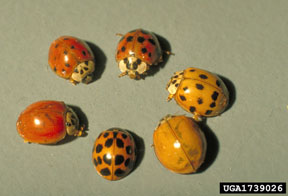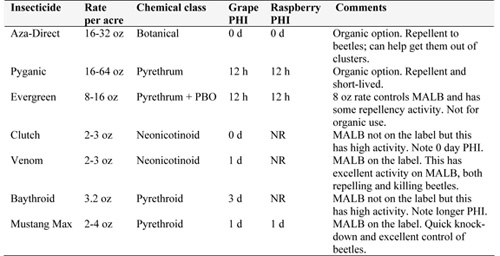A big year for multicolored Asian ladybeetle?
Multicolored Asian lady beetles may pose a threat to Michigan’s grape and raspberry harvests this fall. High aphid levels and ideal weather raise risk. Scout fields, follow thresholds, and consult buyers before using insecticides to prevent fruit taint.
Editor’s note: This article is from the archives of the MSU Crop Advisory Team Alerts. Check the label of any pesticide referenced to ensure your use is included.
Harvest of grapes and fall raspberries is underway, and it's time to be thinking about multicolored Asian lady beetles (MALB). The multicolored Asian lady beetles has become a pest of fall-harvested fruit crops because it seeks the sugary juice and tight spaces found in ripe berries, causing contamination of ripe fruit. If crushed, the beetles can release defensive secretions, tainting juice and wine. Since the worst year of 2001 when this insect tainted a lot of juice and wine across the Midwest and became stuck inside raspberries at harvest-time, it has generally not reached these levels again. But this year is shaping up to be a year where multicolored Asian lady beetles affect harvest of fall crops including grapes and raspberries.

The various colors and spot patterns of the multicolored
Asian ladybeetle. Photo by B. Ree, Texas A&M University, Courtesy of Bugwood.org.
Each fall since 2001, we have been on the lookout for the biological and environmental conditions that can combine to create these problems. For an outbreak year of Asian ladybeetle, it seems you need three key components: 1) high aphid populations for the beetles to feed on, 2) a long warm fall switching to a period with cold night temperatures and warm days, and 3) ripe fruit present when beetles start searching for sugars and overwintering sites. Unfortunately, the fall of 2009 has the potential to cause lady beetle problems for fruit growers in southern Michigan.
Recent reports from southeast and southwest Michigan indicate that soybean fields in southern Michigan are experiencing a late-season surge of soybean aphid with hundreds to thousands per plant in some fields. These aphids provide food for ladybeetles, and there have been high numbers of multicolored Asian lady beetle populations found in some soybean fields. As the soy fields dry up, these insects will need a place to go and prepare for overwintering, which may mean grape clusters and raspberries. In previous Septembers, cold night temperatures followed by warm days have triggered the switch in behavior from aphid-hunting to moving to vineyards, and we have had these conditions in the past few weeks.
At this point, I recommend scouting soybean fields near vineyards or raspberry fields to see what insects are in there. Do you see lots of aphids, or lots of multicolored Asian lady beetles? If so, this is a warning sign that the multicolored Asian lady beetles are likely to move out of the soy fields as soon as they dry down. Regular scouting of fruit crops from now to harvest will allow early detection of beetles getting into clusters or berries. This lady beetle species has distinctive markings on the head (an M or W pattern), and it varies widely in the color and spot markings. For more information on the biology and coloration of this beetle, see the MSU multicolored Asian lady beetles page online at www.ipm.msu.edu/asianladybeetle.htm.
Scouting of fruit crop fields will provide the information needed to make informed decisions about the need to control multicolored Asian lady beetles to prevent the flavor taint, and remove the beetles before harvest. A sampling scheme has been developed at the University of Minnesota to guide winegrape growers’ decisions just before harvest. Their research showed that when 26 clusters are sampled randomly from across a vineyard, the taint taste in the juice was detectable by only 10 percent of the population when five multicolored Asian lady beetles were found in this vineyard sample. So, five beetles in 26 clusters is their action threshold to guide control decisions. For juice grape growers, National Grape Cooperative has established a threshold of six beetles per 10 pound sample of fruit. Attempts to develop a practical method for removing the taint without removing the flavor of the juice or wine have not yet been successful. Individual growers will have to decide what level of comfort they have in allowing beetles in their fruit and the risk of having this taint, but the thresholds described above indicate how sensitive people are to these chemicals.
Some non-chemical methods for reducing multicolored Asian lady beetle infestation include submerging clusters in water after harvest or manually shaking the fruit to release them while picking. These approaches can help reduce infestation, but they may not be practical for management of large acreage fields. Before considering any chemical control method, it is essential to talk with your buyer, processor, or winemaker to make sure that they understand the need for preventing infestation and to make sure they approve of your late-season use of insecticide. This is particularly important for winemakers, given their sensitivity to anything that might affect the aroma and taste of wine. If deciding on a pre-harvest insecticide for multicolored Asian lady beetle control, also be aware of seasonal limits for insecticides that you may have used earlier in the season, e.g. 12.8 oz limit on Baythroid.
If multicolored Asian lady beetles are detected in grape clusters at or above threshold levels as harvest is approaching, there are some effective organic and conventional insecticides with short pre-harvest intervals that can provide beetle control and allow harvest of fruit with much lower levels of contamination. These include the products listed in Table 1 which have demonstrated good activity on multicolored Asian lady beetles in laboratory bioassays and vineyard trials. There is much less data available on efficacy in raspberry, but similar performance would be expected. For any attempt to reduce multicolored Asian lady beetles infestation using insecticides, it is essential that the insecticide reach the target. This means using high water volume and focusing sprays on the clusters. These beetles like to hide in the crevices between berries, so that’s where the spray needs to reach.

NR = not registered
Take-home messages on MALB management this fall
- There are warning signs of a big year for multicolored Asian lady beetles in Michigan fruit that have yet to be harvested.
- This beetle is abundant only in some areas, so scouting will help you detect if and when multicolored Asian lady beetles move from other plants to fruit crops.
- There are some thresholds developed for wine and juice grapes to help with decision-making.
- Check with your winery, processor, or buyer regarding their policy on pre-harvest insecticides.
- If using insecticides, choose a short PHI product and remember that the label is the law.
Dr. Isaacs's work is funded in part by MSU's AgBioResearch.



 Print
Print Email
Email


